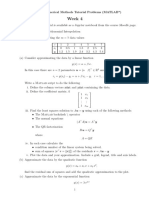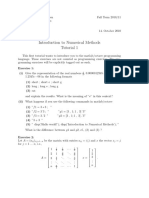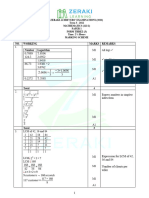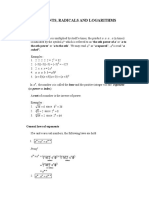Chap2. Exponential and Logarithmic Function
Uploaded by
levisqueen26Chap2. Exponential and Logarithmic Function
Uploaded by
levisqueen26CHAPTER 02
Exponential Function &
Logarithmic Function
Chap2. Exponential function and Logarithmic function 1/.31
2.1 Exponential Function
Solution of Exponential Equation and Exponential
2.2 Inequality
2.3 Logarithmic Function
Solution of Logarithmic Equation and Logarithmic
2.4 Inequality
2.5 Engineering Problem
Chap2. Exponential function and Logarithmic function 2/31
2.1 exponential function
Definition of Exponential Function
Definition 2-1 Exponential Function
𝑎>0 , 𝑎≠1 , 𝑥 ∶ 𝑟𝑒𝑎𝑙 𝑛𝑢𝑚𝑏𝑒𝑟
exponential function 𝑦 = 𝑎𝑥
𝑎 ∶ 𝑏𝑎𝑠𝑒 , 𝑥 ∶ 𝑒𝑥𝑝𝑜𝑛𝑒𝑛𝑡
example 2-1
Evaluate whether the following functions are exponential function or not.
Chap2. Exponential function and Logarithmic function 3/31
2.1 exponential function
Graph of Exponential Function
Graph of 𝑦 = 𝑎 𝑥 (𝑎 > 0, 𝑎 ≠ 1)
[Fig2-1] Graph and characteristics of 𝑦 = 𝑎 𝑥 (𝑎 > 0, 𝑎 ≠ 1)
increase
decrease
graph increase
increase
As the value of x increases, the value of y As the value of x increases, the value of y
increases decreases
charact • Domain : ℝ , Range {𝑦: 𝑦 > 0}
-eristics • Pass through two points 0,1 (1, 𝑎)
• The asymptotic line is x-axis
Chap2. Exponential function and Logarithmic function 4/31
2.1 exponential function
Graph of Exponential Function
Symmetric movement of graph 𝑦 = 𝑎 𝑥 (𝑎 > 1)
symmetry
about x-axis
symmetry symmetry
about y-axis about origin
[Fig2-1] Symmetric relation of the graph 𝒚 = 𝒂𝒙 (𝑎>1)
Chap2. Exponential function and Logarithmic function 5/31
2.1 exponential function
Graph of Exponential Function
example 2-2
Draw the graphs of the following exponential functions.
Chap2. Exponential function and Logarithmic function 6/31
2.1 exponential function
Calculation Rule of Root
⚫ Calculation rule of root
When a> 0, b> 0, m, n ≥ 2
n
n n n a a
1) a b= ab 2) n
= n 3) ( n a ) m = n
am
b b
mn np mp m
4) m n
a = a = n m
a 5) a = n
a
[ Practice problem] Simplify following problems.
6
a a
(1) 4 3
16 X 3
16 (2) 5 2
a x
3
a (a>0) (3) 3
4
3
a a
3 5 5 3 4
x 3 x x x 4 x 5 x
(4) 5 5
3
(5) 3
x x x 4
x 5
x 3
x
Chap2. Exponential function and Logarithmic function 7/31
2.1 exponential function
Exponential Rule
1. Definition of 0 (zero), negative integer (-), and rational number exponential
1 m
(1) a0 = 1 (a ≠ 0) (2) a-n = n
(3) a n = n a m ( where, a>0, m=integer, integer n≥2 )
a
2. Exponential rule
when a > 0, b > 0, x and y = real number
(1) a a = a (2) a a = a
x y x+ y x y x− y xy
(3) ( a x)y = a (4) (ab)x = ax b x
[ Practice problem] Simplify following problems.
1
( − ) −3 −3 2 − 2 − 2
3 1 1 1
−2 2 9 − 43 83
(2) {( a b ) } (3) a a a
2 2 4
( 4) ( a − a )
2
(5){( ) }
(1) 3 16
3 3
1 1
x + x− 2 + 2 1 1
(6) when x + x = 3 (x>0), i)
−
ii) x 4 + x − 4
2
2 2
x + x +3
2 −2
x
1 2
5x
+ 2−3 x
(7) when 2 x + 2 = 3, ( )2 (8) when 4 = 3 − 2 2 ,
2x
−x
2 +2
x
8
Chap2. Exponential function and Logarithmic function 8/31
2.1 exponential function
Size comparison by the properties of exponential function
Theorem 2-1 Size comparison by exponential function
Step1 Make the base of exponents of two numbers equal.
Step2 Evaluate like the following according to the range of the base of
exponent.
∙ If base>1 , the number having larger exponent is larger.
∙ If 1>base>0 , the number having larger exponent is smaller.
example 2-3
Compare the size of the following two numbers.
Chap2. Exponential function and Logarithmic function 9/31
2.2 The solution of exponential equation and exponential inequality
Solution of Exponential Equation
Theorem 2-2 Solution of exponential equation
(1) In case of same base :
when 𝑎 > 0, 𝑎 ≠ 1, 𝑖𝑓 𝑎 𝑓(𝑥) = 𝑎 𝑔(𝑥) , solve 𝑓 𝑥 = 𝑔(𝑥) .
(2) In case of same exponent
when 𝑎 > 0, 𝑎 ≠ 1, 𝑏 > 0, 𝑏 ≠ 1 , one of the followings is true.
∙ if 𝑎 𝑓(𝑥) = 𝑏 𝑓(𝑥) , 𝑎 = 𝑏 .
∙ if 𝑎 𝑓(𝑥) = 𝑏 𝑓(𝑥) and 𝑎 ≠ 𝑏 , solve 𝑓 𝑥 = 0 .
example 2-4
Solve the following exponential equations.
Chap2. Exponential function and Logarithmic function 10/31
2.2 The solution of exponential equation and exponential inequality
Solution of Exponential Inequality
Theorem 2-3 Solution of exponential inequality
Step1 Make the base of both sides of a exponential inequality
equal.
Step2 Calculate like the following according to the range of the
base.
∙ when 𝑎 > 1 , 𝑖𝑓 𝑎 𝑓(𝑥) > 𝑎 𝑔(𝑥) , solve 𝑓 𝑥 > 𝑔(𝑥) .
∙ when 1 > 𝑎 > 0 , 𝑖𝑓 𝑎 𝑓(𝑥) > 𝑎 𝑔(𝑥) , solve 𝑓 𝑥 < 𝑔(𝑥) .
example 2-5
Solve the following exponential inequalities
Chap2. Exponential function and Logarithmic function 11/31
2.2 The solution of exponential equation and exponential inequality
Solution of Exponential Inequality
example 2-6
Solve the following exponential inequalities
Chap2. Exponential function and Logarithmic function 12/31
2.3 Logarithmic Function
Definition of Logarithmic Function
Definition 2-2 Logarithmic Function
When 𝑎 > 0, 𝑎 ≠ 1 , if 𝑎 𝑦 = 𝑥 for 𝑥 (𝑥 > 0)
logarithmic function 𝑦 = log 𝑎 𝑥
𝑎 : base , 𝑥 : antilogarithm
example 2-7
Find the ranges of 𝑥 for the following logarithmic functions to be defined.
Chap2. Exponential function and Logarithmic function 13/31
2.3 Logarithmic Function
Properties of Logarithmic Function
Theorem 2-3 Properties of logarithmic function.
When 𝑎 > 0, 𝑎 ≠ 1 and 𝑥 > 0, 𝑦 > 0 , the followings are established.
(1) log 𝑎 1 = 0 , log 𝑎 𝑎 = 1
𝑥
(2) log 𝑎 𝑥 + log 𝑎 𝑦 = log 𝑎 𝑥𝑦 (3) log 𝑎 𝑥 − log 𝑎 𝑦 = log 𝑎 𝑦
(4) log 𝑎 𝑥 𝑘 = 𝑘 log 𝑎 𝑥 ( 𝑘 : real number)
log 𝑥 1
(5) when 𝑏 > 0, 𝑏 ≠ 1 , log 𝑎 𝑥 =log𝑏 𝑎 (6) log 𝑎 𝑏 = log (𝑤ℎ𝑒𝑟𝑒, 𝑏 ≠ 1)
𝑏 𝑏 𝑎
example 2-8
Simplify the following expressions.
Chap2. Exponential function and Logarithmic function 14/31
2.3 Logarithmic Function
Properties of Logarithmic Function
[ Practice problems.] Determine 𝒙 satisfying following equation.
(1) log 2 3 144 =𝑥
(2) log 8 ( 2 + 3 − 2 − 3 ) = 𝑥
3
(3) log 𝑥 2 2 = 8
(4) log10 log 32 𝑥 = −1
(5) when 𝑥 = 10 + 2 , 𝑦 = 10 − 2, log 64 (𝑥 2 + 𝑥𝑦 + 𝑦 2 ) = ?
2−1
(6) when 𝑥 = , log 3 (𝑥 2 − 6𝑥 + 10) = ?
2+1
Chap2. Exponential function and Logarithmic function 15/31
2.3 Logarithmic Function
Common Logarithm and Natural Logarithm
Of the possible values as the base 𝑎 in 𝑦 = log 𝑎 𝑥 , 𝑎 = 10 and 𝑎 = 𝑒
are used the most.
1 𝑛
The irrational number 𝑒 in natural logarithm is defined as lim 1 + ,
𝑛→∞ 𝑛
𝑒 = 2.718 …
Definition 2-3 Common Logarithm and Natural Logarithm
(1) The logarithm whose the base is 10 is called common
logarithm, and in this case, the base 10 is omitted as follows.
𝑦 = log10 𝑥 = log 𝑥
(2) The logarithm whose the base is 𝑒 is called natural logarithm,
and in this case, the base 𝑒 is omitted and expressed simply as
ln .
𝑦 = log 𝑒 𝑥 = ln 𝑥
Chap2. Exponential function and Logarithmic function 16/31
2.3 Logarithmic Function
Graph of Logarithmic Function
▪ Graph of
[Table 2-2] Graph and characteristics of 𝑦 = log 𝑎 𝑥 (𝑎 > 0, 𝑎 ≠ 1)
increase
graph increase
increase
decrease
y increases with the increase of x y decreases with the increase of x
Charac- • Domain : {𝑥: 𝑥 > 0}, Range ℝ
teristics • Pass through the point (1,0)
• The asymptotic line is y-axis
Chap2. Exponential function and Logarithmic function 17/31
2.3 Logarithmic Function
Graph of Logarithmic Function
Symmetric movement of graph 𝑦 = log 𝑎 𝑥 (𝑎 > 1)
symmetry
about y-axis
symmetry symmetry
about x-axis about origin
[Fig2-3] Symmetric relation of the graph 𝑦 = log 𝑎 𝑥 (𝑎>1)
Chap2. Exponential function and Logarithmic function 18/31
2.3 Logarithmic Function
Graph of Logarithmic Function
example 2-9
Draw the graphs of the following logarithmic functions.
Chap2. Exponential function and Logarithmic function 19/31
2.3 Logarithmic Function
Size Comparison by Logarithmic Function
Theorem 2-5 Size comparison by logarithmic function
Step1 Make the base of two numbers equal.
Step2 Evaluate like the following according to the range of the base.
∙ If base>1 , the number having larger antilogarithm is larger.
∙ If 1>base>0 , the number having larger antilogarithm is smaller.
Chap2. Exponential function and Logarithmic function 20/31
2.3 Logarithmic Function
Size Comparison by Logarithmic Function
example 2-10
Compare the size of the following two numbers.
example 2-11
Compare the size of the following two numbers.
Chap2. Exponential function and Logarithmic function 21/31
2.4 The Solution of Logarithmic Equation and Logarithmic Inequality
Solution of Logarithmic Equation
Theorem 2-6 Solution of logarithmic equation
(1) In case of same base :
When 𝑎 > 0, 𝑎 ≠ 1, 𝑖𝑓 log 𝑎 𝑓(𝑥) = log 𝑎 𝑔(𝑥), solve 𝑓 𝑥 = 𝑔(𝑥) .
Only 𝑥 values that satisfy the antilogarithm condition 𝑓 𝑥 > 0, 𝑔 𝑥 > 0
are solution.
(2) In case that there is the term without logarithm
When 𝑎 > 0, 𝑎 ≠ 1 , if log 𝑎 𝑓(𝑥) = 𝑏, solve 𝑓 𝑥 = 𝑎𝑏
Only 𝑥 values that satisfy the antilogarithm condition 𝑓 𝑥 > 0 are solution.
Chap2. Exponential function and Logarithmic function 22/31
2.4 The Solution of Logarithmic Equation and Logarithmic Inequality
Solution of Logarithmic Equation
example 2-12
Solve the following logarithmic equations.
example 2-13
Solve the following equations.
Chap2. Exponential function and Logarithmic function 23/31
2.4 The Solution of Logarithmic Equation and Logarithmic Inequality
Solution of Logarithmic Inequality
Theorem 2-7 Solution of logarithmic inequality
𝑎 > 0 ,𝑎 ≠ 1
(1) In case of log 𝑎 𝑓(𝑥) < log 𝑎 𝑔(𝑥) :
∙ When 𝑎 > 1, solve 0 < 𝑓 𝑥 < 𝑔(𝑥) .
∙ When 0 < a < 1 , solve 𝑓 𝑥 > 𝑔 𝑥 > 0 .
(2) In case of log 𝑎 𝑓(𝑥) < 𝑏
∙ When 𝑎 > 1, solve 0 < 𝑓 𝑥 < 𝑎𝑏 .
∙ When 0 < 𝑎 < 1 , solve 𝑓 𝑥 > 𝑎𝑏 .
example 2-14
Solve the following logarithmic inequalities.
Chap2. Exponential function and Logarithmic function 24/31
2.4 The Solution of Logarithmic Equation and Logarithmic Inequality
Logarithmic Inequality using the relation between Exponential Function and Logarithmic Function
▪ The relation between exponential function and logarithmic function
The graphs of exponential function and logarithmic function are symmetric
about the line 𝑦 = 𝑥 .
[Fig 2-5] The relation between exponential function and logarithmic function
Chap2. Exponential function and Logarithmic function 25/31
2.4 The Solution of Logarithmic Equation and Logarithmic Inequality
Logarithmic Inequality using the relation between Exponential Function and Logarithmic Function
Theorem 2-8 Solution of complicated inequalities
Step1 Take the logarithm with the proper base on both sides of the inequality.
Take the common logarithm in case that there is no proper base, and
take the logarithm with the base 𝑎 if there is form "log 𝑎 𝑥 “ in exponent.
Step2 Find the solution of complicated inequality by using the formula for
base conversion.
example 2-15
Solve the following inequalities.
Chap2. Exponential function and Logarithmic function 26/31
2.5 Engineering Problem
Reprodution of bacteria
Bacteria are one of the causes of food poisoning.
Under what temperature conditions do bacteria grow?
Non reproducing
1) Over 60℃ : zone
In this section, most of bacteria do not reproduce or die.
Danger zone
2) 5℃~60℃ :
It is a danger zone where the causative bacteria of food
poisoning are most actively reproduced.
3) Below 5℃ : Dormant zone
In this section, most bacteria do not reproduce and
become dormant. [Fig2-6] Tenperature condition
where bacteria grow
example 2-16
The number of bacteria doubles every 20 minutes in the danger zone.
If there were 100 bacteria at first, the number of after 𝑡 hours is as follows.
𝑓 𝑡 = 100 × 23𝑡
Answer the questions.
(a) How many hours does it take for more than 10,000 bacteria?
(b) How many hours does it take for more than 1,000,000 bacteria?
Chap2. Exponential function and Logarithmic function 27/31
2.5 Engineering Problem
Biological half-life
Biological half-life means the time it takes for a radioactive substances to
enter the body to be reduced to half the original amount of radioactivity.
The physical half-life of Strontium-90 is about 28.9 years, and the biologi-
cal half-life is 35 years, which is longer than the physical half-life.
example 2-17
Sievert(Sv) is a unit that measures the degree of biological effects a person receives
when exposed to radiation. Answer the following questions.
(a) If a person has 48𝑚𝑆𝑣 strontium-90 in his body, find the amount that will remain
in the body after 70 years.
(b) If a person has 48𝑚𝑆𝑣 strontium-90 in his body and 16𝑚𝑆𝑣 strontium-90 remains
in his body after 𝑡 years, find the approximate value of 𝑡 to one decimal place.
Chap2. Exponential function and Logarithmic function 28/31
2.5 Engineering Problem
Environment engineering and the amount of water
In environment engineering, the amount of
water in a river or lake is periodically measured
and the amount of water is estimated based on
this. In fact, lakes with large surface areas lose
hundreds of thousands of tons of water each
year due to natural evaporation.
If there is no water flowing into the lakes, lakes
with large surface areas will all evaporate in the
near future. [Fig 2-8] A lake in Australia
that is naturally evaporating
example 2-18
If a lake loses water by 10% every year, find how many years it will take for
the amount of water in this lake to decrease to less than half of the current
year’s water volume.
Chap2. Exponential function and Logarithmic function 29/31
2.5 Engineering Problem
Decibel (radio wave attenuation ratio)
A decibel(dB) is a unit that represents the relative magnitude
of a sound, also known as the radio wave attenuation ratio.
The average household noise at home is about 40dB, the daily
conversation is about 60dB, and the sound of 120-140dB is a
painful level for a person to hear. The decibel is the common
log value of the intensity ratio of the sound, multiplied by 10.
When the intensity of a radio wave changes from A to B after
it passes through a wall, the radio wave attenuation ratio F of
the wall is as follows.
[Fig2-9] decibel level meter
example 2-19
When the intensity of the radio wave passed through the wall (radio wave
attenuation ratio:-20dB) is 0.05, find the intensity of the radio wave before it passes
through the wall.
Chap2. Exponential function and Logarithmic function 30/31
2.5 Engineering Problem
Earthquakes and the Richter Magnitude Scale
Richter magnitude scale is a unit developed by the American seismologist
Charles F. Richter in 1935 to indicate the magnitude of an earthquake.
The formula of Richter magnitude scale is as follows.
A : the seismic magnitude measured by the amplitude of the seismometer
100 km away from the epicenter
A0 : the standard earthquake magnitude
example 2-20
The earthquake that occurred in area A in 2016 had a Richter magnitude scale of 5.8,
and the earthquake that occurred in area B in 2011 recorded a Richter scale of 9.0.
Express how many times the magnitude of the earthquake that occurred in area B is
the magnitude of the earthquake that occurred in area A, as an approximate value to
the first decimal place.
Chap2. Exponential function and Logarithmic function 31/31
You might also like
- Hourglass Workout Program by Luisagiuliet 276% (21)Hourglass Workout Program by Luisagiuliet 251 pages
- The Hold Me Tight Workbook - Dr. Sue Johnson100% (16)The Hold Me Tight Workbook - Dr. Sue Johnson187 pages
- Read People Like A Book by Patrick King-Edited62% (66)Read People Like A Book by Patrick King-Edited12 pages
- Livingood, Blake - Livingood Daily Your 21-Day Guide To Experience Real Health77% (13)Livingood, Blake - Livingood Daily Your 21-Day Guide To Experience Real Health260 pages
- COSMIC CONSCIOUSNESS OF HUMANITY - PROBLEMS OF NEW COSMOGONY (V.P.Kaznacheev,. Л. V. Trofimov.)94% (212)COSMIC CONSCIOUSNESS OF HUMANITY - PROBLEMS OF NEW COSMOGONY (V.P.Kaznacheev,. Л. V. Trofimov.)212 pages
- Donald Trump & Jeffrey Epstein Rape Lawsuit and Affidavits83% (1016)Donald Trump & Jeffrey Epstein Rape Lawsuit and Affidavits13 pages
- Math Study Guide/Notes For Final Exam MCR3U Grade 11 Functions58% (12)Math Study Guide/Notes For Final Exam MCR3U Grade 11 Functions31 pages
- The 36 Questions That Lead To Love - The New York Times94% (34)The 36 Questions That Lead To Love - The New York Times3 pages
- The 36 Questions That Lead To Love - The New York Times95% (21)The 36 Questions That Lead To Love - The New York Times3 pages
- Jeffrey Epstein39s Little Black Book Unredacted PDF75% (12)Jeffrey Epstein39s Little Black Book Unredacted PDF95 pages
- The 4 Hour Workweek, Expanded and Updated by Timothy Ferriss - Excerpt23% (954)The 4 Hour Workweek, Expanded and Updated by Timothy Ferriss - Excerpt38 pages
- Cambridge Senior Maths Ac Vce Mathematical Methods 1 Amp 2 Solutions Manual 9781107520134 1107520134 CompressNo ratings yetCambridge Senior Maths Ac Vce Mathematical Methods 1 Amp 2 Solutions Manual 9781107520134 1107520134 Compress740 pages
- Potenciación IV: Leyes de Xponentes: Trabajando en ClaseNo ratings yetPotenciación IV: Leyes de Xponentes: Trabajando en Clase2 pages
- Introduction To MATLAB Lab 2: (Vectors and Matrices)No ratings yetIntroduction To MATLAB Lab 2: (Vectors and Matrices)21 pages
- Class03_Winter_MCu11_Handout_Feb_18-23 (1)No ratings yetClass03_Winter_MCu11_Handout_Feb_18-23 (1)6 pages
- 2401-Mathematics Paper+With+Sol. MorningNo ratings yet2401-Mathematics Paper+With+Sol. Morning10 pages
- Mathematics 8: Quarter 2 - Week 1 Lesson 1No ratings yetMathematics 8: Quarter 2 - Week 1 Lesson 18 pages
- رياضيات - السنة التاسعة من التعليم الأساسيNo ratings yetرياضيات - السنة التاسعة من التعليم الأساسي215 pages
- Ch.11 Review 2015-2016.notebook January OS, 201No ratings yetCh.11 Review 2015-2016.notebook January OS, 2011 page
- 2022 H2 C8A Integration Techniques - TutorialNo ratings yet2022 H2 C8A Integration Techniques - Tutorial5 pages
- Logarithms and Exponential Functions: Skills CheckNo ratings yetLogarithms and Exponential Functions: Skills Check7 pages
- My First L TEX Document: 2 K 123 Ijk 2 I 123 Abc 3 2 3 2 3 2 2 2No ratings yetMy First L TEX Document: 2 K 123 Ijk 2 I 123 Abc 3 2 3 2 3 2 2 22 pages
- Lecture Transcript 3 (Exponential Functions)No ratings yetLecture Transcript 3 (Exponential Functions)14 pages
- VCE Mathematical Methods Units 3&4 Exam 1 Suggested Solutions Booklet 2021No ratings yetVCE Mathematical Methods Units 3&4 Exam 1 Suggested Solutions Booklet 202110 pages
- Y9 Summer Block 5 WO2 Interpret Graphs Including Reciprocal and Piece Wise 2021No ratings yetY9 Summer Block 5 WO2 Interpret Graphs Including Reciprocal and Piece Wise 20212 pages
- A) The Value of K Shaded Region B Revolved Through 360° About X-AxisNo ratings yetA) The Value of K Shaded Region B Revolved Through 360° About X-Axis4 pages
- ATAR Notes Test 1&2 Circular Functions SolutionsNo ratings yetATAR Notes Test 1&2 Circular Functions Solutions26 pages
- A Brief Introduction to MATLAB: Taken From the Book "MATLAB for Beginners: A Gentle Approach"From EverandA Brief Introduction to MATLAB: Taken From the Book "MATLAB for Beginners: A Gentle Approach"2.5/5 (2)
- Graphs with MATLAB (Taken from "MATLAB for Beginners: A Gentle Approach")From EverandGraphs with MATLAB (Taken from "MATLAB for Beginners: A Gentle Approach")4/5 (2)
- UNIT 2-Introduction To Computer NetworksNo ratings yetUNIT 2-Introduction To Computer Networks12 pages
- Worksheet 1 Memorandum Exponents and Surds Grade 11 MathematicsNo ratings yetWorksheet 1 Memorandum Exponents and Surds Grade 11 Mathematics6 pages
- Basic Mathematics - Module - (Only PDF) - IOQM 2025No ratings yetBasic Mathematics - Module - (Only PDF) - IOQM 202525 pages
- 5.4 Exponential and Logarithmic EquationsNo ratings yet5.4 Exponential and Logarithmic Equations10 pages
- Maths 9709 Paper 3 - Logarithmic and Exponential FunctionsNo ratings yetMaths 9709 Paper 3 - Logarithmic and Exponential Functions37 pages
- Solution To Puzzle 48: Exponential EquationNo ratings yetSolution To Puzzle 48: Exponential Equation5 pages
- Mathematics Mathematics Form 3 Paper 1 Marking Scheme 1No ratings yetMathematics Mathematics Form 3 Paper 1 Marking Scheme 114 pages
- Livingood, Blake - Livingood Daily Your 21-Day Guide To Experience Real HealthLivingood, Blake - Livingood Daily Your 21-Day Guide To Experience Real Health
- COSMIC CONSCIOUSNESS OF HUMANITY - PROBLEMS OF NEW COSMOGONY (V.P.Kaznacheev,. Л. V. Trofimov.)COSMIC CONSCIOUSNESS OF HUMANITY - PROBLEMS OF NEW COSMOGONY (V.P.Kaznacheev,. Л. V. Trofimov.)
- Donald Trump & Jeffrey Epstein Rape Lawsuit and AffidavitsDonald Trump & Jeffrey Epstein Rape Lawsuit and Affidavits
- Math Study Guide/Notes For Final Exam MCR3U Grade 11 FunctionsMath Study Guide/Notes For Final Exam MCR3U Grade 11 Functions
- The 36 Questions That Lead To Love - The New York TimesThe 36 Questions That Lead To Love - The New York Times
- The 36 Questions That Lead To Love - The New York TimesThe 36 Questions That Lead To Love - The New York Times
- Jeffrey Epstein39s Little Black Book Unredacted PDFJeffrey Epstein39s Little Black Book Unredacted PDF
- The 4 Hour Workweek, Expanded and Updated by Timothy Ferriss - ExcerptThe 4 Hour Workweek, Expanded and Updated by Timothy Ferriss - Excerpt
- Cambridge Senior Maths Ac Vce Mathematical Methods 1 Amp 2 Solutions Manual 9781107520134 1107520134 CompressCambridge Senior Maths Ac Vce Mathematical Methods 1 Amp 2 Solutions Manual 9781107520134 1107520134 Compress
- Potenciación IV: Leyes de Xponentes: Trabajando en ClasePotenciación IV: Leyes de Xponentes: Trabajando en Clase
- Introduction To MATLAB Lab 2: (Vectors and Matrices)Introduction To MATLAB Lab 2: (Vectors and Matrices)
- Logarithms and Exponential Functions: Skills CheckLogarithms and Exponential Functions: Skills Check
- My First L TEX Document: 2 K 123 Ijk 2 I 123 Abc 3 2 3 2 3 2 2 2My First L TEX Document: 2 K 123 Ijk 2 I 123 Abc 3 2 3 2 3 2 2 2
- VCE Mathematical Methods Units 3&4 Exam 1 Suggested Solutions Booklet 2021VCE Mathematical Methods Units 3&4 Exam 1 Suggested Solutions Booklet 2021
- Y9 Summer Block 5 WO2 Interpret Graphs Including Reciprocal and Piece Wise 2021Y9 Summer Block 5 WO2 Interpret Graphs Including Reciprocal and Piece Wise 2021
- A) The Value of K Shaded Region B Revolved Through 360° About X-AxisA) The Value of K Shaded Region B Revolved Through 360° About X-Axis
- A Brief Introduction to MATLAB: Taken From the Book "MATLAB for Beginners: A Gentle Approach"From EverandA Brief Introduction to MATLAB: Taken From the Book "MATLAB for Beginners: A Gentle Approach"
- Graphs with MATLAB (Taken from "MATLAB for Beginners: A Gentle Approach")From EverandGraphs with MATLAB (Taken from "MATLAB for Beginners: A Gentle Approach")
- Worksheet 1 Memorandum Exponents and Surds Grade 11 MathematicsWorksheet 1 Memorandum Exponents and Surds Grade 11 Mathematics
- Basic Mathematics - Module - (Only PDF) - IOQM 2025Basic Mathematics - Module - (Only PDF) - IOQM 2025
- Maths 9709 Paper 3 - Logarithmic and Exponential FunctionsMaths 9709 Paper 3 - Logarithmic and Exponential Functions
- Mathematics Mathematics Form 3 Paper 1 Marking Scheme 1Mathematics Mathematics Form 3 Paper 1 Marking Scheme 1























































































































